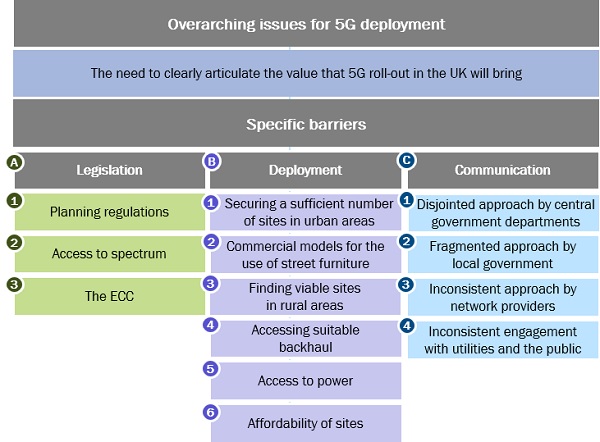Addressing the complexities of mobile network deployment will help to deliver 5G to the UK
To enable the delivery of the greatest possible benefits from 5G, governments worldwide are focusing on ensuring that the right policy foundations are in place.1 Several commercial 5G deployments have already been launched in 2018; 5G networks are expected to emerge more widely during 2019.
The British government has outlined its strong ambitions for 5G leadership and several government-funded 5G trials are on-going. To help realise these ambitions, the British government’s industry advisory forum for telecoms policy (the Broadband Stakeholder Group (BSG)) recently commissioned Analysys Mason to conduct a study to assess the barriers to the commercial deployment of 5G. In this article, we discuss the key findings of that study, published in July 2018.2
Context of the study
The UK was slow to commence the deployment of 4G, but since then, great progress has been made in a limited period. In a little over 5 years, the 4G coverage in the UK has grown such that over 70% of premises are covered by all four mobile operators and over 90% of the country has coverage from at least one operator.3 It is the industry’s perception, however, that the scale and speed of the 4G network deployment was hindered by several complexities relating to mobile infrastructure planning, despite the rapid progress that was eventually achieved. Some of these complexities limited the investment opportunities (for example, long delays in the site deployment process can ultimately make an investment non-viable for operators).
The British government recently sought to address several of these historic planning issues through the Digital Economy Act 2017. In this, the government made changes to the UK’s Electronic Communications Code (ECC) (the key document in the UK relating to planning and interactions between landowners and network builders) with the intention of improving access to land for fixed and wireless telecoms infrastructure. The government increased the permitted development rights for both existing and new mobile sites. These changes are likely to benefit the 5G roll-out, but there was a concern that barriers to 5G deployment might still exist in the UK.
In a previous study, the BSG commissioned Analysys Mason to explore the barriers inhibiting fixed broadband infrastructure deployment.4 The report from that study, published on 23 May 2017, focused on resolving the barriers to fixed network deployment relating to noticing and permit schemes, restriction notices, road traffic management and planning permission for fixed broadband networks. Some of these issues are also relevant to 5G, but the 5G study identified a broader range of potential barriers and uncertainties, including those regarding the way in which the 5G network will be deployed in the UK, and the density of small cells that might emerge.
Key findings
The 5G study identified a single overarching issue regarding market confidence in 5G. This confidence is needed to ensure that the value of 5G for consumers and businesses is clearly articulated by all stakeholders and should reduce the number of risks in the 5G business case, which could, in turn, accelerate investment. Other specific deployment barriers identified broadly fall into three groups: legislation, deployment and communication (including difficulties in communicating between local authorities and planners, and between the industry and local authorities). Taken together, these barriers could significantly affect the timing, coverage and/or feasibility of the 5G network deployment in the UK.
The key barriers are summarised in Figure 1 below.
Figure 1: Key findings from Analysys Mason’s study into the barriers to the commercial deployment of 5G

Source: Analysys Mason, 2018
Implications
In response to our original report for the BSG on the barriers to fixed deployment, the British government has created a ‘barrier-busting’ task force in collaboration with the Department for Digital, Culture, Media and Sport (DCMS). This barrier-busting group is now extending its remit to include mobile and 5G-specific barriers. Some of the key issues for this group include developing guidelines to improve the consistency in how local authorities apply planning rules, while still taking account of the regulations that vary across the devolved nations within the UK, such that quicker and less-bureaucratic processes can be enabled to aid the deployment of both mobile macro sites and small cells.
For example, the new ECC provides guidelines and templates for obtaining access to both land and sites for mobile infrastructure for network providers and landlords. However, the effect of the new ECC is still working its way through the market. While this happens, there will be some uncertainty associated with upgrading existing sites and building new sites, which is unfortunately timed to coincide with periods of intensive activity for mobile network operators while they plan for 5G deployment.
Ultimately, the outputs of this barrier-busting activity will be critical in addressing the planning issues that the BSG report identifies. Without addressing these barriers, a key risk is that network providers are likely to plan more-conservative roll-outs to mitigate the risk of difficult and protracted deployment processes for 5G. Such roll-outs will potentially reduce the socioeconomic benefits of 5G deployment in the UK.
The BSG report sets out a series of recommendations for different British stakeholders: government, local authorities and the 5G industry. The recommendations are interrelated and hence it will be important for all stakeholders to work together with a view to streamlining mobile site planning processes. This is especially important for 5G given the likely increase in the number of sites that 5G networks will use, including smaller (street-level) cells. These challenges are not unique to the UK but are applicable in many other markets where planning processes are negatively affecting the speed of mobile network deployment. In some other markets (such as the USA) policy action has been taken, but, as in the UK, it will take time for the new processes to be accepted.
Analysys Mason has undertaken several studies on 5G deployments in the past 12 months and understands the market dynamics as well as the related issues including those pertaining to spectrum, network optimisation and digital transformation. For more information please contact Janette Stewart, Principal, Consulting at Analysys Mason.
1 For example, see http://ooredoo.com/en/5g-en/.
2 For more information, please see Analysys Mason’s press release, New Broadband Stakeholder Group report identifies urgent 5G mobile deployment challenges to be resolved.
3 See https://www.ofcom.org.uk/__data/assets/pdf_file/0017/113543/Connected-Nations-update-Spring-2018.pdf
4 For more information, please see Analysys Mason’s Lowering barriers to telecoms infrastructure deployment.
Downloads
Article (PDF)Authors

Janette Stewart
Partner, expert in spectrum policy, pricing and valuationLatest Publications
Article
New thinking on spectrum valuation is needed for upper mid-band frequencies
Article
Why spectrum renewal policy matters for network investment and service quality
Article
Does the mobile market need additional sub-1GHz spectrum?

